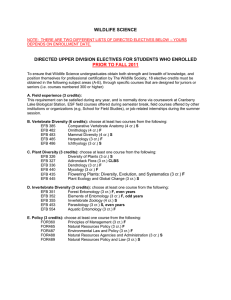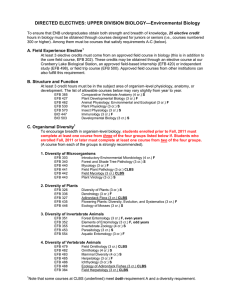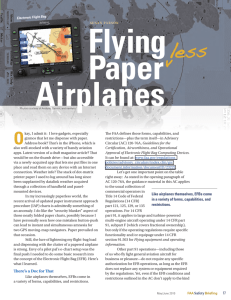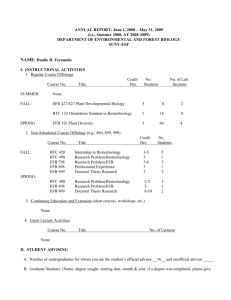Bachelor of Science in Environmental Biology (ENB) Learning Outcome
advertisement
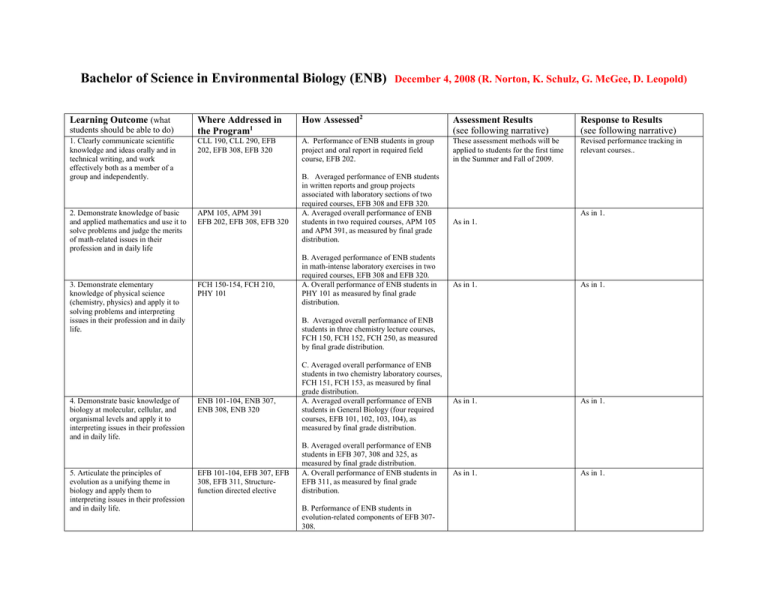
Bachelor of Science in Environmental Biology (ENB) December 4, 2008 (R. Norton, K. Schulz, G. McGee, D. Leopold) Where Addressed in the Program1 How Assessed2 Assessment Results (see following narrative) Response to Results (see following narrative) 1. Clearly communicate scientific knowledge and ideas orally and in technical writing, and work effectively both as a member of a group and independently. CLL 190, CLL 290, EFB 202, EFB 308, EFB 320 A. Performance of ENB students in group project and oral report in required field course, EFB 202. These assessment methods will be applied to students for the first time in the Summer and Fall of 2009. Revised performance tracking in relevant courses.. 2. Demonstrate knowledge of basic and applied mathematics and use it to solve problems and judge the merits of math-related issues in their profession and in daily life APM 105, APM 391 EFB 202, EFB 308, EFB 320 Learning Outcome (what students should be able to do) 3. Demonstrate elementary knowledge of physical science (chemistry, physics) and apply it to solving problems and interpreting issues in their profession and in daily life. 4. Demonstrate basic knowledge of biology at molecular, cellular, and organismal levels and apply it to interpreting issues in their profession and in daily life. 5. Articulate the principles of evolution as a unifying theme in biology and apply them to interpreting issues in their profession and in daily life. FCH 150-154, FCH 210, PHY 101 B. Averaged performance of ENB students in written reports and group projects associated with laboratory sections of two required courses, EFB 308 and EFB 320. A. Averaged overall performance of ENB students in two required courses, APM 105 and APM 391, as measured by final grade distribution. B. Averaged performance of ENB students in math-intense laboratory exercises in two required courses, EFB 308 and EFB 320. A. Overall performance of ENB students in PHY 101 as measured by final grade distribution. As in 1. As in 1. As in 1. As in 1. As in 1. As in 1. As in 1. As in 1. B. Averaged overall performance of ENB students in three chemistry lecture courses, FCH 150, FCH 152, FCH 250, as measured by final grade distribution. ENB 101-104, ENB 307, ENB 308, ENB 320 EFB 101-104, EFB 307, EFB 308, EFB 311, Structurefunction directed elective C. Averaged overall performance of ENB students in two chemistry laboratory courses, FCH 151, FCH 153, as measured by final grade distribution. A. Averaged overall performance of ENB students in General Biology (four required courses, EFB 101, 102, 103, 104), as measured by final grade distribution. B. Averaged overall performance of ENB students in EFB 307, 308 and 325, as measured by final grade distribution. A. Overall performance of ENB students in EFB 311, as measured by final grade distribution. B. Performance of ENB students in evolution-related components of EFB 307308. 6. Demonstrate knowledge of biological diversity by identifying and describing life-history attributes of a wide range of organisms. EFB 202, Field Experience elective, Organismal Diversity electives [3 such courses are required] 7. Demonstrate basic knowledge of the ecological relationships of organisms in natural and humandominated environments at local to global scales, and apply it to interpreting issues in their profession and in daily life. 8. Use the scientific method and apply appropriate laboratory and field techniques to answer questions and solve problems in environmental biology. EFB 120, EFB 202, EFB 320 A. Performance of ENB students in diversity-related components of EFB 202. B. Averaged overall performance of ENB students in three organismal diversity elective courses, as measured by final grade distribution. A. Averaged final grade distribution of ENB students in EFB 120 and in lecture component of EFB 320. As in 1. As in 1. As in 1. As in 1. As in 1. As in 1. B. Performance of ENB students in laboratory component of EFB 320. EFB 101-104, EFB 202, EFB 308, EFB 320 A. Averaged performance in experimental components of EFB 308 and 320. B. Performance of ENB students in experimental components of EFB 202 field course 1 This list includes the key program components that deal with the listed outcome. An online Appendix includes a full matrix of courses and outcomes at XXXXXXXXXXXXXXX and a full explanation of program requirements is given in the Curriculum Plan Sheet, at XXXXXXXX. 2 Performance standards are based on the average grade of ENB students in the indicated outcome-focused embedded project or exercise, or the final course grade (if the entire course focused on the learning outcome). They are scaled as follows: F does not meet the standard; D, C- are approaching the standard; C, C+, B-, B meet the standard; B+, A-, A exceed the standard Explanation Assessment cycle. Data used to assess each learning outcome will be collected annually, beginning in 2009. Full program assessment will occur at 3-year intervals, beginning in 2012, but we will evaluate our assessment methods in 2010. Results of previous assessment. Between 1965-2002, the Bachelor of Science in Environmental & Forest Biology was the single undergraduate program offered by the Department of Environmental & Forest Biology. It was renamed Environmental Biology (ENB) in 2004, as part of the overall curricular revisions noted below. From 20042005 the program was the focus of a structured assessment that is mandated by SUNY at 5-7 year intervals; reports of the associated self-study and external review are available in the online Appendix at XXXXXXX and XXXXXX. This was preceded by unstructured, ad hoc assessments of curricular structure (2002-2004). The principal findings and subsequent adjustments based on these collective assessments were as follows: 1. The single major was too constraining. Although 11 program options were identified, students felt that their investments in specialization were not rewarded by an appropriate degree title. Additional incentives were to increase visibility and recruitment potential in traditional or growing fields like wildlife biology, conservation biology and biotechnology. As a result, the broad, flexible curriculum was retained (as ENB), but six specialized programs were added, most of which grew from the popular program options. Biotechnology was first offered in 2003, and the other five (Wildlife Science, Aquatic & Fisheries Science, Conservation Biology, Forest Health and Natural History and Interpretation) were initiated in 2004. The 2005 external review team felt that our ENB curriculum was somewhat over-structured and could be made more flexible by reducing core requirements. Core courses now comprise slightly less than half of the credit requirements for graduation, which we feel is sufficient to maintain our distinction from the traditional biology curricula of other SUNY units. With the introduction of a new freshman biology sequence (below), we will reconsider second-level biology offerings in 2009; part of this will relate to directed-elective requirements (see online Appendix, Curriculum Plan Sheet at XXXXXXX), which could be altered to slightly increase curricular flexibility. 2. Freshman biology was non-traditional in scope and had significant gaps in content. Since the inception of the program in 1965, freshman biology has comprised two courses, General Botany and Principles of Zoology. While the courses evolved over several decades to be more inclusive than their names suggest, class time was insufficient for presenting some important material that is usually included in modern introductory biology courses. Since we admit many transfer students, the absence of a more traditional sequence also created problems with articulation. Beginning in 2008, freshman biology now comprises four courses: General Biology I and II, and associated laboratory courses (EFB 101-104). Coverage is now equivalent to that of most major universities, and of community colleges that serve as major sources of transfer students. The 2005 review team recommended that our better teachers be assigned to the first-year classes: now, each of the three faculty members assigned to freshman biology is a dedicated, highly student-oriented teacher. 3. Insufficient hands-on experience in some classes, and problematic timing of EFB 202. The 2005 review team responded to student interviews by recommending that courses with field trips be less focused on “note-taking in the field” and more on hands-on exercises. This critique was shown to all biology faculty members, who were asked to evaluate the perceived problem and correct any shortcoming. But in general, ENB students spend much time in the field engaged in activities other than note-taking, and we feel that an examination of syllabi, rather than relying on several student interviews, would have provided a different picture. The review team also recommended increasing the flexibility of our required 3-week summer field course (EFB 202) at our Cranberry Lake Biological Station. They felt that the student body is too heterogeneous: while the course is scheduled after the freshman year, many take it after the sophomore or even junior years. The review team recommended allowing alternative field experiences, particularly for transfer students. We have increased our efforts to promote post-freshman year scheduling and encourage transfer students to take EFB 202 as early as possible. Transfers increasingly enter ESF with little or no science background, and while they may be more personally mature than post-freshmen, they are no more advanced in biology. 4. Competencies in areas other than science and analytical skills are weaker. The 2005 review team suggested – based on several student interviews, not course content analysis – that competencies in writing, mathematics, and group-dynamics were not stressed sufficiently, or not sufficiently reinforced. The college has since implemented standardized math-placement examinations prior to enrollment, with the results being used to recommend appropriate mathematics classes to incoming freshman or transfer students. The college has added two levels of remedial mathematics classes to aid deficient students. Now, most freshmen students join a residential Learning Community, one focus of which is to improve communication skills; associated with this is a “writing across the curriculum” project, in which students complete writing assignments that span certain shared, required courses (e.g. CLL 190, EFB 101, FCH 150). Beginning in 2009 we will have specific assessments of writing, math and group-dynamic skills in several required courses, as indicated in the matrix above.
